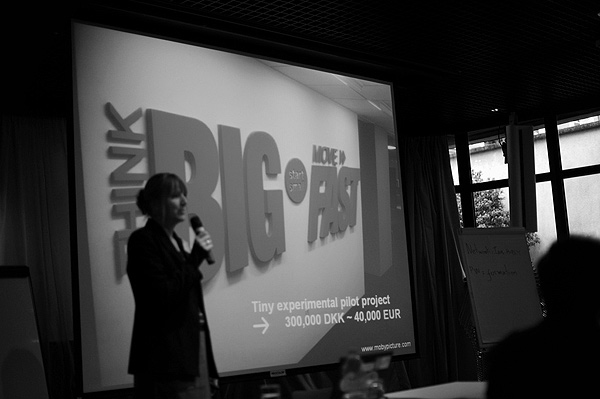Case Study: Danish Museums on Twitter
The Open Data Case Studies Workshop took place at the end of January in Paris, organised by Europeana and INA (Institut national de l'audiovisuel). The aim of the workshop was to evaluate the potential of ‘Open’ and analyse real life examples of services based on open data and open content in the cultural heritage sector.

Merete Sanderhoff, Researcher at SMK, presenting at Europeana’s Open Data Case Studies Workshop in Paris.
Five case studies were presented from the BBC, Statens Museum for Kunst - the National Gallery of Denmark (SMK), Netherlands Sound and Vision Institute, the Polish Digital Libraries Federation and Europeana. These case studies will form a larger white paper on open data, due to be published later this spring. In the meantime, we will be highlighting each case study on an individual basis. We have already showcased the work Europeana did with partners on Pinterest on the Pro blog and now we’re looking at HintMe, a shared mobile museum platform using Twitter's API to connect collections and engage users in dialogue about art. Users in a gallery can use HintMe on their mobile device to see what others have said about the artwork they are looking at and add their own comments on Twitter using the designated hashtags.
A group of Danish art museums joined forces to develop a shared mobile platform based on open content. SMK initiated the collaborative pilot project between 11 Danish art museums. One of the main objectives was to build a mobile tool for art interpretation and engagement to be used by many museum partners based on the following three common principles; all Public Domain content is freely shareable and re-usable, an existing platform is utilised without custom-building a new one, and target users take part in creating and developing the experience. We caught up with Merete Sanderhoff, Researcher at SMK and asked her a few questions to get some more insight on the project:
What is the ‘big idea’ behind this project?
MS:Basically the main idea for us was the close collaboration between art museums in Denmark to explore the benefits of opening up collections for re-use online. As a result of re-licensing these collections, we wanted to facilitate our visitors to start using mobile devices as in-gallery tools, enabling them to engage with the museum, artworks and each other online.
How did the project create value, both for end-users and participating institutions?
MS:We believe that through opening up collections and utilising the viral power of Twitter, we are exposing our collections to the unlimited possibilities of re-use across the web – essentially enabling digitised art collections to become useful and relevant in new ways. I like to think that we are bridging the gap between institutions, their collections, visitors, and online engagement. As a result, we are creating proactive dialogue online, which in the end encourages the creation of content.
What channels were used and why? Also, what benefits have resulted from this pilot project?
MS:In order for the project to scale we wanted to use a platform that already existed, therefore we utilised Twitter because it provided us with the functionalities that we needed, for example, content production is manageable and hashtags offer a simple way to tag individual artworks. As mentioned in the case study, one of the major benefits so far has been the adoption of Creative Commons licences by a number of Danish Museums. By communicating the benefits of CC licences, we hope to attract other museums to open up their collections for re-use on Twitter and other social platforms.
What’s next?
MS:We are interested in exploring ways in which we can make HintMe an indispensable tool for museums. We are also considering how we can increase participation and integrate audio on the platform to enhance the user experience and encourage users to look closer at the artworks. As this is an experimental pilot project, we are interested in hearing your ideas and experiences. As a result of the project there has been keen interest from the Danish educational sector at the prospect of gaining access to more Open Educational Resources from the country's art museums. Furthermore, Wikimedia Commons is keen to harvest more high quality images from Danish art museums, and we are keen to look into the benefits of uploading our collections on Wikipedia. Watch this space…
Try out the beta version of HintMe at http://hints.o8e.dk
You can learn more about what they did and what the results were from the embedded case study below, or alternatively you can download it.
Are you interested in learning more, have a question or simply want to share your experiences? You can get in touch with the author of this case study on Twitter (@MSanderhoff) or directly through email (Merete.Sanderhoff@smk.dk).

